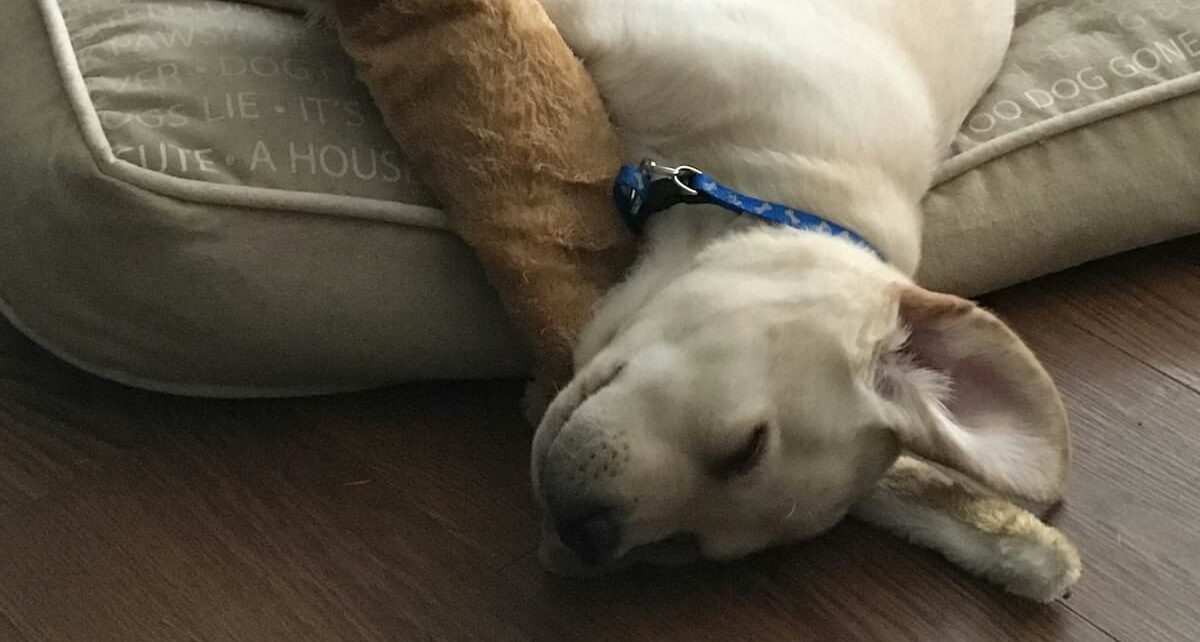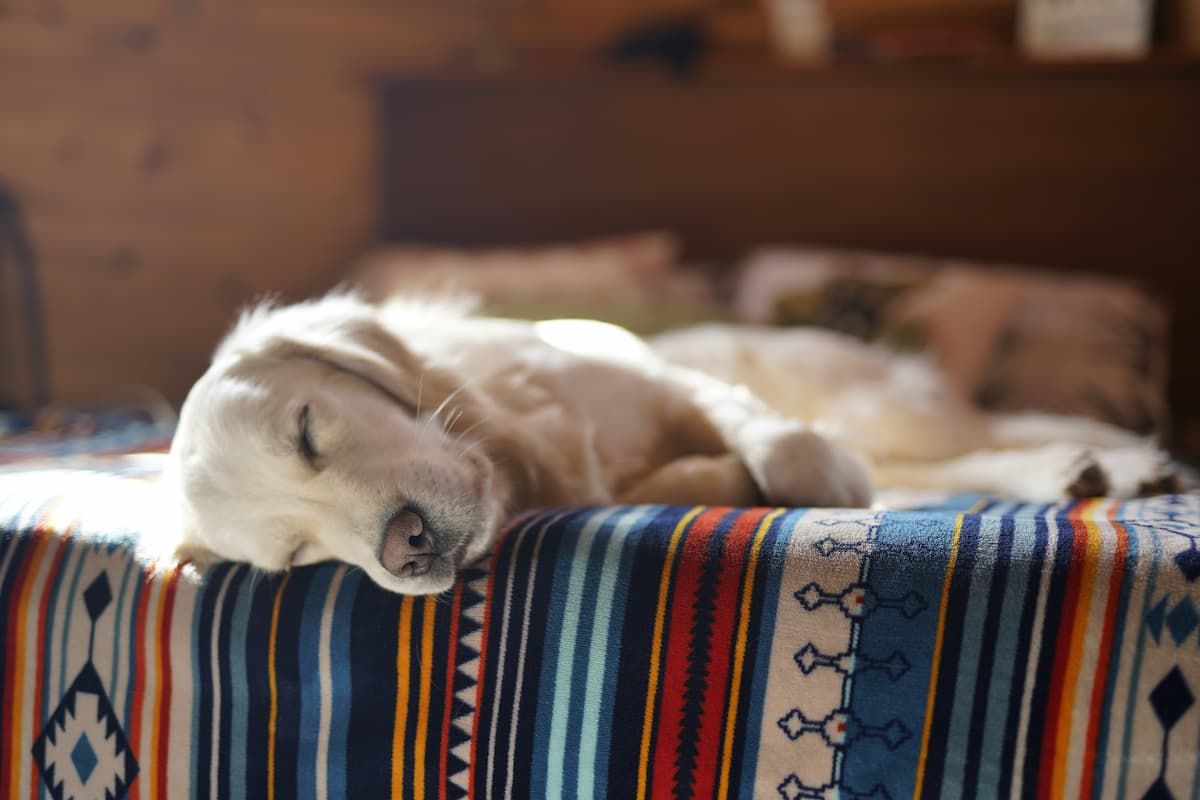Have you ever wondered what goes on inside the canine brain while those furry little paws twitch, noses wriggle, and a symphony of barks, yips, and howls escapes their slumbering lips?
It’s the age-old mystery of why dogs talk in their sleep.
This article shed some light on this phenomenon.
Exploring the Science Behind Dogs Talking in Their Sleep
Have you ever observed your furry friend talking in their sleep?
It’s truly a fascinating sight to see, but have you ever wondered why dogs do this?
Science has the answer as to why our beloved pups engage in this adorable activity.
One reason dogs talk in their sleep is due to their dream state.
Just like humans, dogs enter a phase of sleep called rapid eye movement (REM) sleep, during which their brains are incredibly active.
During this stage, dogs may twitch, whimper, or even make barking sounds as they dream.
This vocalization is their way of expressing what they experience in their dreams, much like we might talk or make noises in our sleep.
Additionally, dogs talking in their sleep can also be a result of their social behavior.
As pack animals, dogs rely on communication to interact with one another.
Through barks, growls, and howls, they convey various messages to their pack members.
So, when dogs talk in their sleep, they may be reliving their interactions and conversations with their canine buddies from the day.
It’s their subconscious mind replaying these social situations and allowing them to express their thoughts verbally.
Different Types of Canine Sleep Talking
1. Murmuring and Whimpering
One of the most common types of sleep talking in dogs is murmuring and whimpering.
While they’re in a deep slumber, you may observe your furry pal making soft noises or even producing high-pitched whines.
This can occur when dogs are dreaming about something exciting or even when they’re having a nightmare.
As pet parents, it’s our duty to provide a calming environment and reassure them if they seem distressed.
2. Barking and Growling
Another form of sleep talking that dogs often exhibit is barking and growling.
Yes, that’s right! Your adorable pooch might be having a “ruff” conversation while they’re fast asleep.
This type of vocalization can occur when they’re dreaming about chasing squirrels, defending their territory, or simply having a good old play session.
It’s important to note that when dogs are engaged in this type of sleep talking, their bodies may also exhibit corresponding movements, like wagging their tails or twitching their legs.
3. Howling
Ah, the enchanting sound of a howling dog!
For some dogs, howling during sleep seems to be quite natural.
Just like barking, it can occur when they’re experiencing dreams related to playing, communicating with other dogs, or even when they’re imitating the sounds they hear around them.
So, don’t be surprised if you catch your furry friend serenading the moon in the middle of the night!
Common Triggers for Sleep Talking in Dogs
Rest assured that sleep talking in dogs is a relatively common occurrence.
Just like humans, our canine companions can sometimes vocalize sounds and even bark while they snooze.
But what exactly triggers this unusual behavior?
Here are some of the common factors that make our dogs chatter in their sleep:
1. Dreaming About Favorite Activities
One of the main triggers for sleep talking in dogs is dreaming about their favorite activities.
Whether it’s a vigorous game of fetch, a thrilling squirrel chase, or an exciting belly rub session, dogs tend to show their enthusiasm even in their dreams.
So, when your pup starts barking or making other vocalizations during their sleep, it could be because they’re reliving the joy and excitement of their most cherished activities.
2. Reacting to External Stimuli
Another common trigger for sleep talking in dogs is their reaction to external stimuli.
Dogs have incredibly sharp senses, and even while they’re asleep, they can pick up on sounds, smells, or even slight movements in their surroundings.
So, if there’s a sudden noise or a familiar scent wafting through the air, it’s highly likely that your pooch will respond to it, resulting in sleep talking.
3. Processing Emotional Experiences
Just like us, dogs process their emotional experiences while they slumber.
They may be replaying a heartwarming encounter with their human family members, reminiscing about a day at the park with their four-legged friends, or even working through moments of anxiety or fear.
These intense emotions can manifest as sleep talking, as dogs express their inner thoughts and feelings through vocalizations during REM sleep.
Tips to Ensure a Peaceful Sleep for Your Dog
Now that we know why dogs talk in their sleep, let’s focus on how we can ensure they have a peaceful snooze despite their dream chats.
Here are some tips to consider:
1. Create a soothing bedtime routine: Establishing a consistent routine before bedtime helps dogs relax and prepare for sleep.
Whether it’s a leisurely walk, a gentle brushing session, or a calming belly rub, these activities signal to your furry friend that it’s time to wind down and enter dreamland.
2. Provide a comfortable sleeping environment: Just like humans, dogs appreciate a cozy bed for a restful sleep.
Invest in a quality dog bed that suits your pup’s size and preferences.
Additionally, consider the location of their sleeping area – ensuring it’s quiet, dimly lit, and away from any potential disturbances will promote a peaceful sleep.
3. Create a white noise ambiance: Some dogs find comfort in ambient sounds that help mask external noises, providing a more serene sleeping environment.
You can achieve this by leaving a fan running, playing soft instrumental music, or utilizing specialized white noise machines designed for pets.
The gentle background noise can help minimize disruptions and soothe your dog’s sleep.
Remember, talking in their sleep is just another delightful aspect of your dog’s fascinating world.
With these tips, you can ensure your furry friend enjoys a peaceful slumber, even during those noisome dream chats.
So, next time you catch your dog having a nighttime conversation, revel in the chatter and let them enjoy their dreams to the fullest.
FAQ
Q: What exactly is happening when dogs talk in their sleep?
A: When dogs talk or make sounds in their sleep, it’s thought to be related to their dreams.
Just like humans, dogs experience different sleep stages, including REM (rapid eye movement) sleep, which is when dreams occur.
During this stage, their brain activity increases, and it’s believed that their dreams somehow translate into vocalizations.
Q: So, are they actually “talking” in their sleep?
A: Not exactly.
While it might sound like they are talking or even barking, dogs are not using actual words during their sleep.
Instead, their vocalizations are more like whimpers, growls, or soft howls.
It’s as if they are mimicking the motions of speaking but without the intention of conveying a specific message.
Q: Is it possible for dogs to communicate something in their sleep?
A: While we can’t be certain, most experts agree that the noises dogs make while dreaming are primarily instinctive and not an attempt to communicate.
These sounds often reflect experiences or emotions they had during the day.
For example, they might ”bark” while dreaming about chasing a squirrel or “whine” if they feel anxious.
It’s their subconscious mind working through their daily experiences.
Q: Can we know what dogs are dreaming about?
A: Unfortunately, we can’t get inside a dog’s mind to uncover the exact contents of their dreams.
It remains a fascinating mystery.
However, studies suggest that dogs could be dreaming about various things like playing, exploring, or even interacting with other animals.
Just like us, their dreams seem to be influenced by their experiences while awake.
Q: Should we wake up a dog when they are talking in their sleep?
A: It’s generally best to let sleeping dogs lie, including when they’re ”talking” in their sleep.
Waking them up abruptly may startle them or disrupt their sleep cycle, which can lead to confusion or grogginess.
As long as they’re not showing any signs of distress or discomfort, it’s perfectly fine to leave them be to enjoy their dream world.
Q: Is talking in their sleep something all dogs do?
A: Not all dogs talk in their sleep, but it’s more common in some breeds than others.
For instance, you might find that Labrador Retrievers or Beagles engage in verbal dream conversations more frequently than other breeds.
It’s just another one of the quirky and lovable traits that make our furry friends so unique.
Q: Can sleep talking indicate a problem in dogs?
A: In general, occasional sleep talking or vocalizations in dogs are considered normal and harmless.
However, if you notice a sudden increase in frequency, intensity, or if your dog seems distressed or uncomfortable while sleeping, it’s always wise to consult with your veterinarian.
They can help rule out any underlying health issues causing abnormal sleep patterns.
Q: How should we respond when our dogs talk in their sleep?
A: The best approach is to simply observe and enjoy the show!
It can be amusing and heartwarming to witness our furry pals engaged in their slumber symphony.
Resist the urge to wake them up or interfere unless they seem distressed.
It’s a fascinating glimpse into their inner world, and they’ll appreciate you allowing them to continue their dreamy conversations undisturbed.
So, next time your dog starts chattering away in their sleep, remember that they’re just exploring their dreams and having a little sleep-time chat.
Enjoy the adorable moment and let your furry friend sleep soundly.
Wrapping Up the Discussion
As it turns out, our beloved furry friends are just as chatty in dreamland as they are in reality.
From adorable yips and growls to wagging tails and twitching paws, their slumber-time conversations are enough to warm even the coldest hearts.
So, why do dogs talk in their sleep?
Well, just like us humans, they’re simply replaying their daily adventures, chasing squirrels in the park, and bonding with their favorite humans.
It’s their way of reliving the doggy version of action-packed movies right inside their dreams.
But perhaps we could take a moment to marvel at how similar we are to our four-legged companions.
Just like us, they express their emotions, excitement, and fears even when they’re fast asleep.
It’s a gentle reminder that the bond between humans and dogs is deeper than we often realize.
So, the next time you catch your pooch engaged in a late-night conversation with the Sandman, take a moment to cherish it.
For in those precious moments, when they wag their tails and let out cute little barks, you’re witnessing their inner worlds coming to life.
It’s like a secret doorway granting you a glimpse into the magical realm of their dreams.














